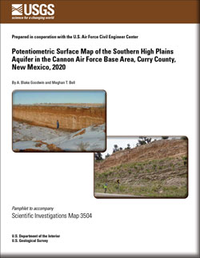Potentiometric Surface Map of the Southern High Plains Aquifer in the Cannon Air Force Base Area, Curry County, New Mexico, 2020
Links
- Document: SIM 3504 pamphlet (1.42 MB pdf) , HTML , XML
- Plate: SIM 3504 sheet (20.5 MB pdf)
- Dataset: USGS Dataset—USGS Water Data for the Nation
- Download citation as: RIS | Dublin Core
Abstract
Declining water levels and the potential impact on water resources on and around Cannon Air Force Base (AFB), New Mexico, has necessitated an up-to-date review of the potentiometric surface to evaluate the availability of water resources for future use. Analysis of groundwater-flow directions and hydraulic gradients can provide an understanding of depletion by heavy groundwater pumping and recharge through playa lakes, as well as the relationship between the groundwater levels and underlying geology. The objectives of this study, conducted by the U.S. Geological Survey in cooperation with the U.S. Air Force Civil Engineer Center, are to assist Cannon AFB in understanding and interpreting current and local hydrologic conditions and to evaluate groundwater-level change from 2015 to 2020 using new and historical data. A groundwater potentiometric surface contour map was constructed to better understand the Southern High Plains aquifer around Cannon AFB and to show the altitude of the water-table surface and groundwater-flow patterns. Four hydrographs were created from periodic measurements of groundwater levels in wells on and around Cannon AFB to provide information about historical groundwater-level changes and visualize trends from the water-level records. The long-term trend present in all four hydrographs is a steady decline in groundwater levels, with some areas declining faster than others. The groundwater-level change map presented in this study provides a visual representation of the change in groundwater level from the winter 2015 to winter 2020 measuring events. Results show that among corresponding wells measured in 2015 and 2020, 50.7 percent indicated a decline in water levels, 29.9 percent indicated neutral water levels, and 19.4 percent indicated a rise in water levels. The region to the north of the groundwater trough on Cannon AFB contained most of the groundwater-level rises, whereas the regions located near the trough and just west of Clovis, N. Mex., contained most of the declines. These results suggest that continued monitoring of declining groundwater levels in the area would provide valuable decision-support information for assessing the sustainability of this water resource.
Suggested Citation
Goodwin, A.B., and Bell, M.T., 2023, Potentiometric surface map of the Southern High Plains aquifer in the Cannon Air Force Base area, Curry County, New Mexico, 2020: U.S. Geological Survey Scientific Investigations Map 3504, 1 sheet, 18-p. pamphlet, https://doi.org/10.3133/sim3504.
ISSN: 2329-132X (online)
Study Area
Table of Contents
- Acknowledgments
- Abstract
- Introduction
- Methods
- Results and Discussion
- Summary
- References Cited
| Publication type | Report |
|---|---|
| Publication Subtype | USGS Numbered Series |
| Title | Potentiometric surface map of the Southern High Plains aquifer in the Cannon Air Force Base area, Curry County, New Mexico, 2020 |
| Series title | Scientific Investigations Map |
| Series number | 3504 |
| DOI | 10.3133/sim3504 |
| Publication Date | June 15, 2023 |
| Year Published | 2023 |
| Language | English |
| Publisher | U.S. Geological Survey |
| Publisher location | Reston, VA |
| Contributing office(s) | New Mexico Water Science Center |
| Description | Report: vi, 18 p., Dataset; 1 Sheet: 21.00 × 28.00 inches |
| Country | United States |
| State | New Mexico |
| County | Curry County |
| Other Geospatial | Cannon Air Force Base area |
| Online Only (Y/N) | Y |


